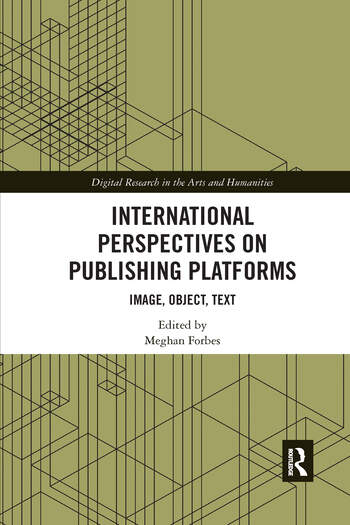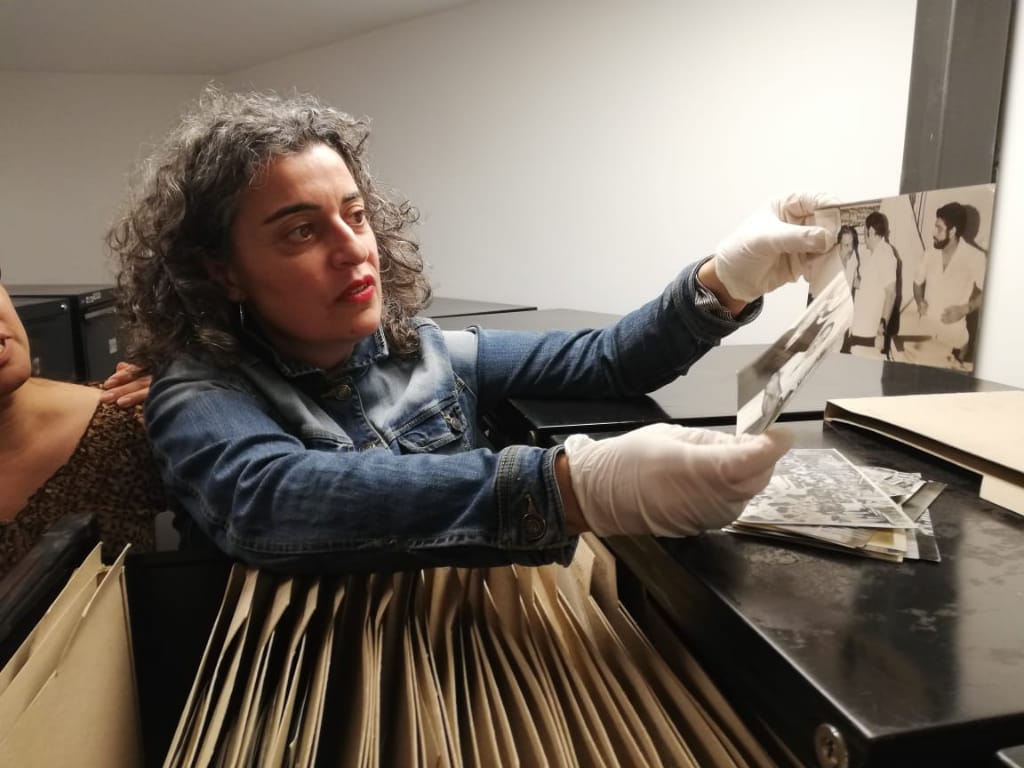A Multi-faceted and Global Perspective on Periodicals—in Every Sense
Meghan Forbes, ed., International Perspectives on Publishing Platforms: Image, Object, Text. New York and Oxford: Routledge, 2019, 268 pp.
Periodicals have traditionally been a favorite format of artists when it comes to experimenting on the blank page. There are several reasons for this, one of them being that magazines create communities even if their members are almost invisible to one another, dispersed as they may be over regional, national, and even continental geographies. Moreover, because of their time-limited nature, which is—a priori—ephemeral or, at least, specific to a certain time span, magazines tend to offer greater freedom for experimentation, since, unlike books, they do not generate the expectation of a finished or conclusive work. And yet, maybe partly for the same reasons, magazines have been less studied from an art historical perspective than other publishing formats in the field of art, such as books or posters, to cite just two examples. Efforts to fill this gap in the literature are to be welcomed; and the volume International Perspectives on Publishing Platforms: Image, Object, Text, edited by Meghan Forbes, is one such effort.
Forbes is a writer, translator, and specialist in contemporary Slavic studies, as well as a former C-MAP Fellow for Central and Eastern Europe at the Museum of Modern Art in New York and former Leonard A. Lauder Postdoctoral Fellow in Modern Art at the Metropolitan Museum of Art. In her detailed introduction, she makes clear that this collection of essays aims to integrate various thoughtful, precise, and indeed original viewpoints. The originality lies in the fact that the essays in this book are interwoven by a series of thematic connections that extend across the three broad sections into which they are structured. These sections—entitled “Image”, “Object” and “Text”—are presented as intriguing thematic “umbrellas” that work in a metaphorical rather than a literal way. “The goal of this book,” Forbes says, “is not one of mere accretion, simply an expanding of the canon, so to speak. Rather it offers, when read as a whole, a theoretically and methodologically diverse approach to the periodical and related print culture, and engages associated questions with regard to collecting, preserving, and archiving” (p. 2). This statement encapsulates the range of conceptual connections that make this book remarkable and intellectually appealing and render it worthy of discussion in some detail.
 The first of these connections is the “publishing – printing” equation, that is, the acknowledgement of the cultural meaning embedded in format and technology, or the intimate interconnection of medium (printed text, calligraphy, etc.) and message: of form and content. Clara-Iris Ramos, a specialist in the cultural implications of printing technologies, has stated elsewhere that “the manufacture of formats, the technologies associated with their reproduction or distribution, and the democratisation of the media or their censorship, cannot be dissociated from the political and historical phenomena of their present. And clearly, nor are they independent from the history of mechanical printing, its systems and its uses in underground contexts. […] Publishing has always been linked to access to certain media and the politics of reproducibility.”(Clara-Iris Ramos, “La microedición y sus microtecnologías (1ª parte),” Visual, May 2019, http://visual.gi/la-microedicion-y-sus-microtecnologias-1a-parte/, accessed May 2022. The translation into English is mine.) In other words: the way a publication is produced is anything but a culturally innocent circumstance and therefore deserves analysis. Examples of this point of view in this book are to be found in Jennifer Bajorek’s article, which explores the impact of the family photographic studio on the artistic practice of the Nigerian artist Kelani Abass (pp. 25-44); Kenan Tekin’s analysis of the artist Ali Suavi’s short-lived magazine Ûlum Gazetesi, published in Paris in the second half of the 19th century (pp. 179-199); and Hannah Probsting’s focus on the experimental typographical practice of avantgarde artist Kurt Schwitters (pp. 200-223).
The first of these connections is the “publishing – printing” equation, that is, the acknowledgement of the cultural meaning embedded in format and technology, or the intimate interconnection of medium (printed text, calligraphy, etc.) and message: of form and content. Clara-Iris Ramos, a specialist in the cultural implications of printing technologies, has stated elsewhere that “the manufacture of formats, the technologies associated with their reproduction or distribution, and the democratisation of the media or their censorship, cannot be dissociated from the political and historical phenomena of their present. And clearly, nor are they independent from the history of mechanical printing, its systems and its uses in underground contexts. […] Publishing has always been linked to access to certain media and the politics of reproducibility.”(Clara-Iris Ramos, “La microedición y sus microtecnologías (1ª parte),” Visual, May 2019, http://visual.gi/la-microedicion-y-sus-microtecnologias-1a-parte/, accessed May 2022. The translation into English is mine.) In other words: the way a publication is produced is anything but a culturally innocent circumstance and therefore deserves analysis. Examples of this point of view in this book are to be found in Jennifer Bajorek’s article, which explores the impact of the family photographic studio on the artistic practice of the Nigerian artist Kelani Abass (pp. 25-44); Kenan Tekin’s analysis of the artist Ali Suavi’s short-lived magazine Ûlum Gazetesi, published in Paris in the second half of the 19th century (pp. 179-199); and Hannah Probsting’s focus on the experimental typographical practice of avantgarde artist Kurt Schwitters (pp. 200-223).
The second relevant connection that Forbes highlights in her introduction is the one that exists between publishing, on the one hand, and preserving and archiving on the other. The connection is further enhanced by acknowledging that periodical publications are “archives” of information in their own right: ultimately, what is a magazine editor if not an “archivist” who carefully chooses content from an ample range of sources for presentation in a particular way, and thereby expands meanings with new associations? But the interdependency of publishing, preserving, and archiving also works on another level, namely that where archival methodologies impact the way an archive is made available for consultation – and even interpreted. How does the way magazines and periodicals are accessed by scholars – in particular, through the digitization and circulation of contents online – modulate the meaning of all the components making up such an archive?
This is the point of departure of “Contemporary Art Magazines: The Archive in the Archive”, Camilla Salvaneschi’s overview of the contemporary art magazine Parkett, which became well known due to its personal perspective on writing and publishing about art and was in print between 1984 and 2017. In this text (pp. 151-174), Salvaneschi reports on the different ways in which the magazine has continued to exist after ceasing publication, one of which is via a digital archive and a series of printed publications. As the author underlines, the complexity of the ways in which the temporal dimension unfolds in the process of digitization and online publication by which Parkett’s contents are now available online greatly enriches the magazine’s potential as a historical document.
The connection between publishing and archiving is also relevant in terms of creating community, as discussed in the texts by Zanna Gilbert and María A. Cabrera Arús, who write respectively about the networks of mail art that crisscrossed Latin America in the sixties and the seventies (pp. 105-132), and about the “Cuba Material” blog, for which Cabrera Arús has gathered images and texts documenting Cuban ephemera and artifacts from the period between the Cuban Revolution, in 1959, and the Fall of the Berlin Wall in 1989 (pp. 133-150). In both cases the act of publishing was, and is, meant not only to convey content, but also to provide a way for individuals living in complex political circumstances to stay connected and share a metaphorical common space.
The third connection has to do with geography: this book brings together commentaries on geographically dispersed projects that extend the field of research beyond the limits of the classical Western, white, middle-class canon that to a large extent continues to determine historiographical analysis, and this approach has the virtue of linking experiments that would otherwise remain disconnected. Without denying that the editorial starting point is the Western cultural tradition (with a particular emphasis on Roland Barthes), this book opens the topic to wider intellectual and artistic contexts by including case studies of periodical publishing in places and times so distant as 20th century and contemporary Nigeria, India, Latin America, the Caribbean, and Japan, as well as the Ottoman empire in the mid-19th century, and Central Europe in the 1920s. Such an expansion of the field of study, Forbes hopes, will contribute to “modestly correct[ing] this offhanded dismissal of non-Western print production as outside the purview of the ‘modern’ world, as well as to trac[ing] many multilinguistic and transnational instances of network formation” (p. 5).
Indeed, the mere fact of uniting these editorial projects in a scholarly volume in English is, in itself, a suggestive gesture, as it breaks the vicious circle whereby periodicals (and any other printed material) from areas of the non-English-speaking world are neither preserved nor studied in English language collections and archives, making it impossible to determine whether one issue is the cause or the result of the other.
Finally, this quest for openness does not stop at geopolitical issues. It also expands the definition of “periodical publication” by including among the topics covered experiments in sound, calligraphy and typography, magazine headers of which only the first issue was ever published, and a digital archive of domestic and everyday memorabilia. The reconsideration of this definition calls into question the very meaning of the term “periodical”: as Nana Ariel points out in her essay “One-Time Periodicals, Unrealized Manifestos,” the terms “magazine” and “periodical,” commonly used as synonyms, in fact describe quite different things (p. 98). While “magazine” is etymologically connected to the concept of space (deriving from the French magasin, “storehouse”), “periodical” puts the focus on the question of temporality. It is precisely the overlapping of both axes –spatial and temporal– that best defines the conceptualization of “periodical publication” as presented in this book.
With these and other interesting contributions, International Perspectives on Publishing Platforms achieves the objective Forbes sets out in the introduction, which is to present the chosen subject –the publishing of periodicals and magazines– from truly novel angles, both in terms of the theoretical approach and in a methodological, geographical, and temporal sense. Despite the vagueness of its title –the only aspect of this book that might warrant a negative reaction– International Perspectives on Publishing Platforms: Image, Object, Text is not just another collection of academic texts of varying merit and theme. On the contrary, taken as a whole, these contributions crystallize in a thought-provoking and truly multidisciplinary vision.
Additionally, by presenting heterogeneous projects which are not necessarily comparable in all respects, this book clears a space for new juxtapositions and intertwined investigations to be conducted in the future. It therefore provides a welcome and necessary breath of fresh air in the art historical analysis of magazines and other periodicals, the study of which is still quite new, since it is only recently that these and other models of publishing practices have gained a certain status within the catalogue of formats of contemporary art.




